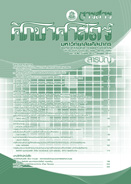ผลของการจัดการเรียนรู้ตามแนวคิดการเรียนรู้เชิงรุกและแนวคิดการเรียนการสอนบนเว็บแบบผสมผสาน เพื่อการออกแบบการศึกษานอกสถานที่เสมือนและส่งเสริมความคิดสร้างสรรค์ของนักศึกษาครุศาสตร์ ศึกษาศาสตร์ระดับปริญญาบัณฑิต
Main Article Content
Abstract
ผลการศึกษาพบว่า 1. กลุ่มทดลองที่เรียนแนวคิดการเรียนรู้เชิงรุกและแนวคิดการเรียนการสอนบนเว็บแบบผสมผสานมีคะแนนความคิดสร้างสรรค์ก่อนและหลังทดลองแตกต่างกันอย่างมีนัยสำคัญทางสถิติที่ .01
2. กลุ่มทดลองที่เรียนแนวคิดการเรียนรู้เชิงรุกและแนวคิดการเรียนการสอนบนเว็บแบบผสมผสานมีคะแนนความคิดสร้างสรรค์แตกต่างกันหลังทดลองกับกลุ่มควบคุมที่เรียนตามแนวคิดการเรียนรู้เชิงรับและแนวคิดการเรียนการสอนแบบเผชิญหน้าอย่างมีนัยสำคัญทางสถิติ.01
3. กลุ่มทดลองที่เรียนแนวคิดการเรียนรู้เชิงรุกและแนวคิดการเรียนการสอนบนเว็บแบบผสมผสานมีคะแนนการออกแบบการจัดการศึกษานอกสถานที่เสมือนก่อนและหลังทดลองแตกต่างกันอย่างมีนัยสำคัญทางสถิติที่ .01
4. กลุ่มทดลองที่เรียนแนวคิดการเรียนรู้เชิงรุกและแนวคิดการเรียนการสอนบนเว็บแบบผสมผสานมีคะแนนการออกแบบการศึกษานอกสถานที่เสมือนแตกต่างกันหลังทดลองกับกลุ่มควบคุมที่เรียนตามแนวคิดการเรียนรู้เชิงรับและแนวคิดการเรียนการสอนแบบเผชิญหน้าอย่างมีนัยสำคัญทางสถิติ .01
5. กลุ่มทดลองมีความพึงพอใจในกิจกรรมเชิงรุกทั้ง 8 กิจกรรมโดยภาพรวมอยู่ในระดับมาก โดยได้ ค่าเฉลี่ย 4.18 ส่วนเบี่ยงเบนมาตรฐาน 0.68 กิจกรรมที่ได้รับคะแนนเฉลี่ยมากที่สุดได้แก่ กิจกรรมเชิงรุกที่ 4 Focused student journal ค่าเฉลี่ย 4.36 ส่วนเบี่ยงเบนมาตรฐาน 0.58 อยู่ในระดับมากสำหรับกิจกรรมที่ได้รับความพึงพอใจน้อยที่สุดได้แก่ กิจกรรมเชิงรุกที่ 1 One minute paper ค่าเฉลี่ย 3.98 ส่วนเบี่ยงเบนมาตรฐาน 0.75 อยู่ในระดับมาก
6. ค่าขนาดอิทธิพลเป็นไปในทางบวก ได้แก่ คะแนนความคิดสร้างสรรค์มีค่า 1.37 และการออกแบบการศึกษานอกสถานที่เสมือนมีค่า 2.69 ซึ่งแสดงว่าตัวแปรต้นได้แก่ การจัดการเรียนรู้ตามแนวคิดเชิงรุกและการเรียนการสอนบนเว็บแบบผสมผสานมีค่าอิทธิพลทางบวกต่อตัวแปรตาม
Effect of organizing active learning and hybrid learning on design of virtual field trip and to enhance creativity for undergraduate education students
The purpose of this research was effect of organizing active learning and hybrid learning on design of virtual field trip and to enhance creativity for undergraduate education students. The subjects were sixty undergrad student, academic year 2012, faculty of Education, Chulalongkorn University. They selected with the criteria and divided into a control group and an experimental group which each was thirty. The experimental group received active learning and hybrid learning approach and the control group received passive learning and face to face learning approach. This research instrument consisted of creative assessment by Torrance, design of virtual field trip evaluation, satisfy in learning questionnaire. Data were analyzed by mean, standard deviation, t-test and effect size
The results showed that
1. The experimental group which was received active learning and hybrid learning approach was different pretest and posttest in creative score significantly at .01 level
2. The experimental group which was received active learning and hybrid learning approach was different posttest of the control group which received passive learning and face to face learning approach in creative score significantly at .01 level
3. The experimental group which was received active learning and hybrid learning approach was different pretest and posttest in design of virtual field trip score significantly at .01 level
4. The experimental group which was received active learning and hybrid learning approach was different posttest of the control group which received passive learning and face to face learning approach in design of virtual field trip score significantly at .01 level
5. The experimental group was very satisfied in all activities by mean at 4.18 and sd. at 0.68. The activity that was the highest satisfy was activity 4: Focused student journal by mean at 4.36 and sd. at 0.58 which was in high level but the activity was the lowest satisfy was activity 1: One minute paper by meanat 3.98 and sd. at 0.75 at a high level
6. Positive effect size appeared in creativity at 1.37 and design of virtual field trip at 2.69, which indicates that active learning and hybrid learning approach had influence on the dependent variable.


